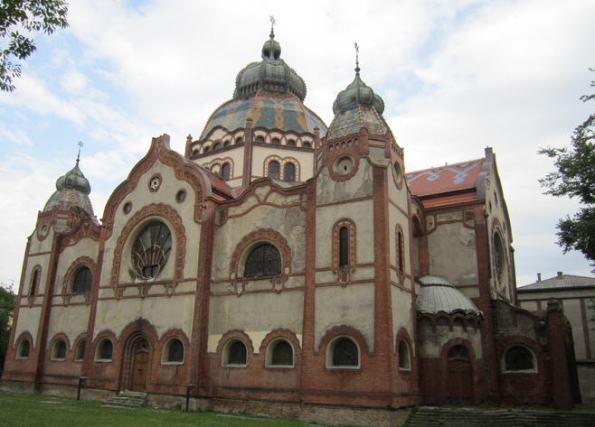I would like to share two documents with you. Both are reactions to the Hungarian government’s resolve to rewrite twentieth-century Hungarian history. The first is a letter sent by Steven J. Fenves, a Holocaust survivor and one of our readers.
Steven and I met thanks to Hungarian Spectrum. We exchanged a couple of e-mails from which I learned that he was born in Subotica/Szabadka (Yugoslavia) where his father, Lajos Fenyves, was the manager of Minerva Kiadó which published, among other things, Napló, the largest-circulation Hungarian language daily in Vojvodina.
The other day I received a new e-mail from him. It contained a copy of a letter he addressed to Professor Randolph L. Braham. I was very moved and admired him greatly for the sacrifice he made for the sake of truth. I asked permission to publish his letter here. You can learn more about Steven Fenves from his account of his trials after the family was deported to Germany.
* * *

Hungarian Art Nouveau synagogue in Subotica/Szabadka
Dear Professor Braham,
This note is to let you know that your moving Open Letter has prompted me to act accordingly, albeit on a much more modest scale.
Subotica, in Serbia – also known as Szabadka – won funding for two projects in the competition for Hungary’s fund for the 2014 commemorations: one for opening a Holocaust Information Center by the Subotica Jewish Community organization and one for an exhibition in the Subotica City Museum. For the first, I was asked to authorize the use of my mother’s name, Klara Gereb (Geréb Klári), for the Holocaust Information Center. (She was a locally well-respected graphic artist between the two world wars and perished in Auschwitz.) Initially, I assented to this request. The second project, not surprisingly, was to mount an exhibition of my mother’s work in the City Museum. For this, I promised to lend an unspecified number of artworks. (Because of the extensive looting during the deportations in June 1944, the Museum owns only 7 pieces of her work; I, however, own over 200 works on paper because in 1944 our former cook waded in among the looters and saved a large binder of her works, which she returned to my sister and me when we came back from the camps to Subotica in 1945.)
My resolve to support these two projects was badly shaken when I saw in Hungarian Spectrum a photograph of Sándor Szakály. There, facing him, was a bust of a Hungarian csendőr, complete with the black Bowler hat embellished with the flying black cock-feathers, exactly as worn by those gendarmes when they herded us into the makeshift ghetto and soon thereafter loaded us into the boxcars destined for Auschwitz. The map behind Mr. Szakály showed, of course, the pre-World War I map of Hungary, with Subotica well within its borders. It was extremely painful for me to realize that the Hungarian government that sponsors this man also funds the two 2014 activities in Subotica.
And then came your open letter requesting the removal of your name from the Data and Information Center (Téka és Információs Központ) at the Holocaust Memorial Center (Holokauszt Emlékközpont), reprinted in Hungarian Spectrum.
So I took action. First, I asked the director of the Jewish Community organization to remove my mother’s name from the name of the center. He responded that he had ordered the name to be erased (“töröltetem a nevet a központ nevéből” – a harsh expression that I have not read since the 1940′s). Second, I informed the Museum that I will not contribute in any way to the exhibition: no loans of artwork and no written contributions to any catalog or other printed material. I have not yet received a reply.
As I said at the beginning, these are two small actions not comparable to your momentous one.
Sincerely yours,
Steven Fenves
University Professor Emeritus, Carnegie Mellon University
source: HungarianSpectrum

 MMA countdown – Free Artists welcomes the resigned MMA-members!
MMA countdown – Free Artists welcomes the resigned MMA-members! TRANSZPARENCIÁT!
TRANSZPARENCIÁT!